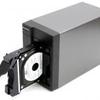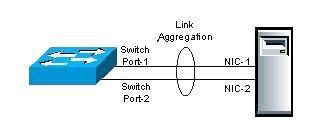NAS Explained
Asustor AS6202T
The Asustor AS6202T can house two hard drives or SSDs, if you need more there are 4, 8 and 10-tray model as well. The 2T unit is tied towards two Gigabit Ethernet jacks, meaning 1000 / 8 minus QOS and random overhead like error-correction is roughly a maximum of 100 to 125 MB/sec on a single Gigabit Ethernet connection.
The tested AS6202T can house two storage units, these can be set up in Single, JBOD, RAID 0/1. Once you have installed your hardware, you'll need to bind the NAS towards your Ethernet with a CAT5e/6e cable to a switch; the Asustor NAS offers more connectors though including USB 3.0. When you have your HDDs installed, and the device connected through your PC you'll need to start-up a software suite to bind and setup your configuration. Please look at the install CD for that. Or if you have a smartphone, simply use a smartphone app like FING and scan the network, Asustor will show up with a corresponding IP. Type in the IP into your browser and you can start setting up the unit.
- Intel Celeron 1.6 GHz Quad-Core Processor (Automatic Overclocking to 2.24 GHz) - N3150 (quad-core)
- Read Speed of up to 115 MB/s and 225 MB/s Under Link Aggregation.
- 4 GB Built-in Dual-Channel DDR3L High Speed Memory (Expandable up to 8 GB, 4 GB x2)
- HDD: 2 x SATA3 6Gb/s; 3.5"/2.5" HDD/SSD
- Maximum Internal Raw Capacity: 20 TB (10 TB HDD X 2, Capacity may vary by RAID types)
- Supports Hot Swappable Drives
- Expansion: USB 3.0 x 3, USB2.0 x 2, eSATA x 2
- Network: Gigabit Ethernet x 2
- Output: HDMI 1.4b x 1, S/PDIF x1
- Smart Fan Temperature Control
You network toplogy needs to match though:
- Your switches need to support Link aggregation (layer2)
- Your NAS needs to support Link aggregation (this one obviously does)
- You need multiple Gigabit controllers in your PC or use multiple PCs
- You need fast enough storage units
- You'll need multiple network links for and to your switch.
Power Consumption (based on eight used HDDs):
- Power Consumption: 16.6W (Operation);
- 9.5W (Disk Hibernation);
- 0.96W (Sleep Mode)
Operating system compatibility wise the NAS supports file sharing across Linux, UNIX, Mac, and Windows platforms. We will be testing with Windows 8.1 and 10. Also for the more advanced among you, Windows AD (Active Directory) is supported to help create an easy-to-access environment. SSH login and web page SSL login enables users to transfer, store, and share data securely. Since this product acts as a server ALL PC's within your network can connect to it, with or without access rights. You can manage it from any client as you simply log into the web-interface and configure it. The unit's size is: 163.5(H) x 108(W) x 230(D) mm and weighs in at 2 (kg) / 4.41 (lb).
Network Attached Storage
Times have changed and our storage requirements have moved from Kilobytes, to Megabytes, to Gigabytes and now even Terabytes of storage. And sure, it won't be long until we reach Petabytes either. Oh and after that there's Exabyte and then Zettabyte!
| File Storage Capacity by Bits and Bytes | ||||
| Byte | Kilobyte | Megabyte | Gigabyte | |
| Kilobyte | 1,024 | 1 | 1,024 | 1,048,576 |
| Megabyte | 1,048,576 | 1,024 | 1 | 1,024 |
| Gigabyte | 1,073,741,824 | 1,048,576 | 1,024 | 1 |
| Terabyte | 1,099,511,627,776 | 1,073,741,824 | 1,048,576 | 1,024 |
| Petabyte | 1,125,899,906,842,620 | 1,099,511,627,776 | 1,073,741,824 | 1,048,576 |
| Exabyte | 1,152,921,504,606,850,000 | 1,125,899,906,842,620 | 1,099,511,627,776 | 1,073,741,824 |
| Zettabyte | 1,180,591,620,717,410,000,000 | 1,152,921,504,606,850,000 | 1,125,899,906,842,620 | 1,099,511,627,776 |
So we passed the Terabyte marker. With our hefty demand in storage capabilities, the industry had to constantly adapt and introduce new features in hardware. Storage units got much bigger in volume over the year, 6 TB HDDs have just been introduced onto the market with 10 TB already in the pipeline. In that line of storage solutions there is one product series growing fast and now reaching SOHO and consumer based markets. They are called NAS units, network attached storage. And there has been a lot of development in these nifty little boxes. Pretty much they are little servers that you can hook onto your network and then function as file-server.
The NAS units are often small, do not use a lot of power compared to say your PC, but they are highly configurable, offer redundancy as some models can even handle RAID internally. Network Attachable Units are among the most advanced home servers available on the market today. Products feature multiple HDDs setups, partitions, RAID, USER and USERGROUP based access, FTP, web server, MySQL, hot swappable drives; these are just some of the features that a NAS unit can handle. And though expensive, a product like this is just too darn handy when it comes to file-storage and management over your network.


